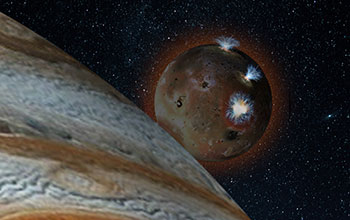Multimedia Gallery
Gemini tracks collapse of Io's atmosphere (Image 3)
Observations by the Gemini Observatory show that the thin atmosphere of Jupiter's moon Io undergoes dramatic changes during frequent daily eclipses with the giant planet. These changes in temperature appear to cause the moon's atmosphere to collapse during daily eclipses. In this graphic, part of a series of images by an artist depicting the atmospheric collapse of Io, in full eclipse, lo's atmosphere "collapses" as sulfer dioxide gas becomes frost on the moon's surface. The atmosphere redevelops when sunlight returns. [Image 3 of 3 related images. Back to Image 1.]
More about this image
To learn more, see the NSF News From the Field story Gemini tracks collapse of Io's atmosphere during frigid eclipses. (Date image taken: Aug. 2, 2016; date originally posted to NSF Multimedia Gallery: Dec. 27, 2016)
Credit: Southwest Research Institute/Andrew Blanchard
See other images like this on your iPhone or iPad download NSF Science Zone on the Apple App Store.
Images and other media in the National Science Foundation Multimedia Gallery are available for use in print and electronic material by NSF employees, members of the media, university staff, teachers and the general public. All media in the gallery are intended for personal, educational and nonprofit/non-commercial use only.
Images credited to the National Science Foundation, a federal agency, are in the public domain. The images were created by employees of the United States Government as part of their official duties or prepared by contractors as "works for hire" for NSF. You may freely use NSF-credited images and, at your discretion, credit NSF with a "Courtesy: National Science Foundation" notation.
Additional information about general usage can be found in Conditions.
Also Available:
Download the high-resolution JPG version of the image. (3.5 MB)
Use your mouse to right-click (Mac users may need to Ctrl-click) the link above and choose the option that will save the file or target to your computer.

